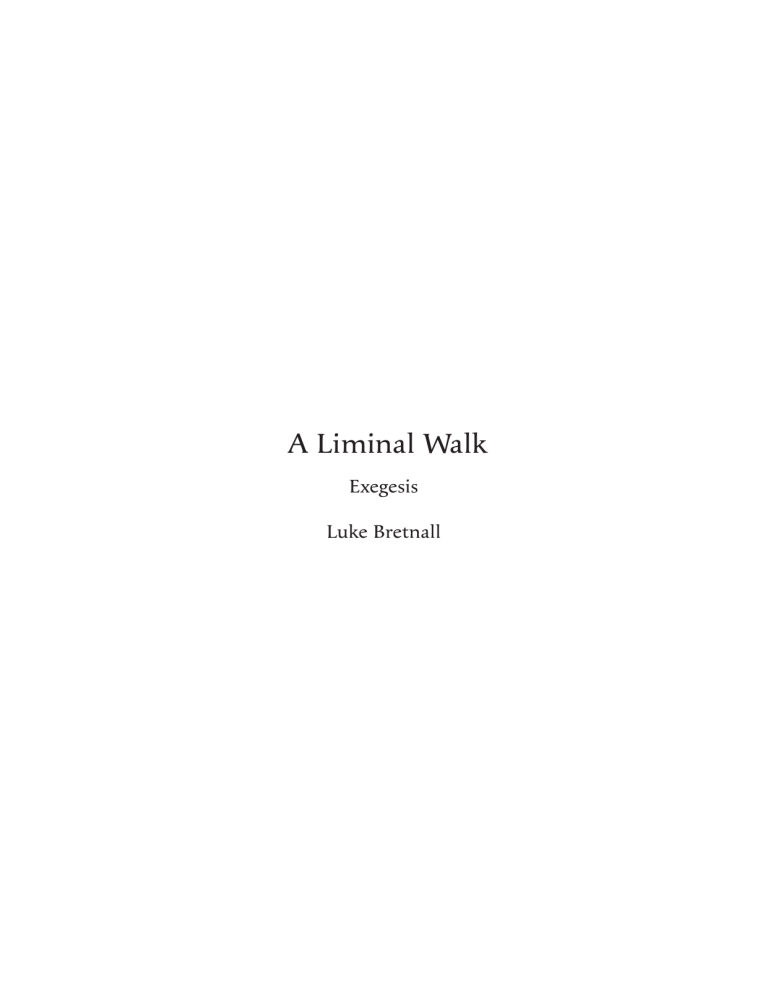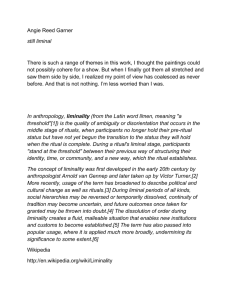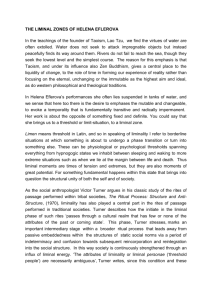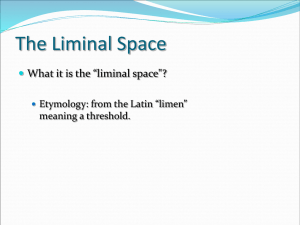
A Liminal Walk Exegesis Luke Bretnall Contents \ Abstract pg. 3 \ Introduction pg. 4 \ Research Contexts pg. 6 \ Method pg. 12 \ Project Output pg. 17 \ References pg. 19 \ List of Figures pg. 20 Abstract Fort Lane was once known as the entertainment centre of Auckland. City dwellers drawn to its cinema and theatre environment created a real connection between people and the space they occupied. What was once a cinematic urban landscape, now used as a transitional lane to get from A to B. Unaware of their union between self and space, occupants add to the dissociation we see in the urban landscape of Fort Lane. How can occupants’ awareness of self in space be restored in the urban landscape of Fort Lane? I wish to propose a public design installation within Fort Lane through the assessment of liminal space and the cinematic phenomena related to urban landscapes. This public space will introduce a series of textured panels, creating multiple pathways focusing on moments of separation, transition, and incorporation while moving through Fort Lane. Introduction Fort Lane is home to some of the most significant developments in Auckland’s formation as a major city. The urban environment reflects the scale of change the shared lane has endured. Once a trading port, a space for the sale of fine goods, most notably the hotspot for theatre and entertainment. The opening of Queens and Everybody’s picture theatre in the 1910s took advantage of cinema’s increasing popularity. Simultaneously, the interest in cinema grew. Many new theatres appeared, possessing grand interiors adding to the entertainment and excitement of the experience. This focus on detail hinted at a strong connection between people and their spatial environment when experiencing their cinematic journey. Unfortunately, the connection has slowly diminished into the disengaged occupants of Fort Lane we see today. ‘A Liminal Walk’ aims to rekindle the connection between people and space. Creating an environment that stimulates awareness of self in space will accomplish this lost connection. What does self-awareness in space mean? Although Fort Lane currently is a shared public space, it lacks the spatial and programmatic conditions that enhance the shared experience. Making it a problem for spatial design to solve. “Spatial design is always about the interrelationship between people and the environment.” (name/date). Fort Lane had gained attention for its run-down and seedy character for some time. It was providing an opportunity for people to avoid interaction with Fort Lane altogether. All it takes to reconnect people with their spatial environment is to add a bit of entertainment. A visual prompt to experience the space in a way people may not have imagined. Swedish artist David Svensson showed how this visual prompt was persuasive through his Eyelight Lane light installation in Fort Lane. The red neon light runs through a section of Fort Lane, bouncing between walls and transforming the way we see space. The project concept explores liminal space and the phases that create the space. How is liminal space created? Liminal space is necessarily ambiguous and uncertain, resulting in spatial conditions that allow a more vital awareness of self in space. What are the spatial characteristics of liminal space? My public design installation is interactive, but not in a physically stimulating manner. This sense of interaction focuses more on the movement of one’s body through space. The focus lies with the dialogue created between occupants and the transitional moments experienced through the installation. Moments of separation, transition, and incorporation shed light into the urban landscape one sits within, offering further insight into one’s awareness of self in space. This installation is a temporary addition to Fort Lane, providing an intended sudden change of scenery for its occupants. The idea of ambiguity and uncertainty for some can provoke an anxious response. This response is necessary to nudge occupants into the ‘liminal space’ and build a stronger relationship between people and their urban landscape, which would otherwise never be discovered. In this exegesis, I will investigate the questions I have surfaced through the analysis and reflection of my design processes and methods. These questions help to unpack my project concept, the installation’s intention, and how I made design decisions. Research Contexts Arnold Van Gennep The term ‘liminality’ originates from anthropological studies, the study on human behavior and societal patterns. Arnold Van Gennep coined this term, an ethnographer well known for analyzing liminal space in ‘The Rites of Passage.’ A rite of passage (ritual) occurs when an individual or social group goes through a significant status change. These are usually milestones or ceremonies such as graduation, weddings, and funerals. Van Gennep distinguished a pattern that accompanied a ritual which included three phases: separation (pre-liminal), transition (liminal), and incorporation (post-liminal) (Van Gennep, 1909). Therefore, for liminal space to occur, there must be a ritual/s taken place. Mirco rituals exist with the site, some existing now and remains of pre-existing rituals during Fort Lane’s cinematic era. Although liminal space comes from anthropology, a ritual’s phases can also be viewed as a spatial experience. In the context of Fort Lane, the activity of walking through the lane is a ritual. People’s daily walk may consist of using Fort Lane as a shortcut from A to B. This is a moment of separation, transition, and incorporation from a spatial structure rather than a social structure. In order to create liminal space, the three phases must occur within the design installation. Given that the liminal state is central to the relationship between ‘self’ and ‘the world’ (Arya, 2012), I have chosen to explore the concept of liminality to achieve my main goal: How can occupants’ awareness of self in space be restored in the urban landscape of Fort Lane? Victor Turner An anthropologist named Victor Turner acknowledged and continued the investigation into Van Gennep’s study of liminal space. Turner isolated his research towards the liminal phases identified by Van Gennep. He began to investigate the significant attributes that define each phase. Turner concluded that each liminal phase must be distinctly different from the previous and future state. This difference identifies the change in space, atmosphere, and relation to surroundings. In the context of human behavior, Turner believes “the attributes of liminality are necessarily ambiguous” (Turner, 1969), and the liminal individuals are in a dissolved and disorientated state. This interpretation can be interchangeable with the spatial design and programming of my installation. The transitional phase must identifiably look and feel different from the past or future states to achieve this. Richard Serra Richard Serra is an American sculptor well known for his large-scale steel structures. Most of his work exhibited appears out of place and forces viewers to engage in bodily dialogue with the structure (Fig 1.1). Thus, resulting in a stronger awareness of self in space. Serra possesses a firm opinion on art, claiming he is “not interested in the notion that art serves something. Art is useless, not useful” (2016). Although this viewpoint contradicts the impact of his art, it playfully poses a new question into the purpose of art. Alternatively, maybe this was Serra’s intention by making this statement. Serra has redefined art’s purpose, expressing that art is useless when not engaged in bodily dialogue with its audience. For example, his sculpture collection ‘Torqued Ellipses’ explored the idea of disorientation concerning the audience movement, as mentioned with Victor Turner’s interpretation of liminal space. These sculptures encourage movement to understand its form and purpose, which would not be discovered if standing still or outside the structure (Fig 1.2). The movements through Torqued Ellipses can be viewed as a transitional liminal phase, as moments of dissolution and disorientation occur while moving within the structure. The audience becomes separated from the previous spatial structure once entering the sculptures, potentially coming out with a new perception, which is Serra’s overall goal. “I am interested in restructuring the perception of a given space through the way my work organizes the space. “(Serra, 2007). Fig 1.1: ‘Tilted Arc’ was removed after the public viewed it as disruptive and frustrating to manevour around. Fig 1.2: Audience engaged in bodily dialogue within ‘Torqued Ellipses’. Olafur Eliasson Olafur Eliasson is a Danish artist who works with mostly large-scale installation art and sculptures. Much like Serra, Eliasson aims to create environments that enhance the viewer’s awareness, perception, and curiosity through his art. One of his most famous installations was ‘The Weather Project’, exhibited at Tate Modern in London. Eliasson brings nature into the museum environment by recreating an indoor sun and sky landscape. ‘The Weather Project’ invites the audience to think about the relationship between themselves and the space they are inhabiting (Fig 2.1). “My works demand the visitors’ engagement; they are dependent on viewers to co-produce them,” (Eliasson, 2015). Like Eliasson, I have a clear conceptual intention behind my installation. However, this does not mean people require the competence to understand why they feel a certain way in my proposed space. If they experience Fort Lane in a new way, this is successful. Eliasson explains, “I do not mind if people are moved by my work without knowing, or even caring, about any of the theories behind it.” (Eliasson, 2015). Taking away instructions and guidance allows the audience to interact in the purest form (Fig 2.2). Take museum exhibitions, for example. In the chapter ‘Noodling Around with Exhibition Opportunties’, Elaine Gurian explains that museum exhibition curators, whether consciously or unconsciously, impose learning impediments on the audience (Gurian, 1991). This is done without an understanding of the visitor’s capability to learn and interact with art. Museum exhibitions often seek an ‘appropriate’ audience behavior. Eliasson’s work drives for a focus on the relationship made between people and space/art, which, in my opinion, is more valuable than focusing strictly on space/art itself. Fig 2.1: Audience at ‘The Weather Project’ glance at the vast reflection of themselves and the artifical sun. Fig 2.2: The audience have no guidelines on how to interact with the installtion, encourging a variation of positioning. Method Spatial Relations Spatial relations, or spatial editing, is the construction of film space through a series of shots. This technique serves to position the audience within an intended setting. My installation’s spatial editing was a critical technique to construct the liminal phases of separation, transition, and incorporation. Model-making helped envision how these spaces may look and feel within a conceptual narrative (Fig 3.1). Viewing the site with a cinematic lens was critical in elucidating the context that defines our urban landscapes. Referring to Richard Koeck’s inquiry into ‘Cine-Scapes’ (cinematic and landscapes), using film as a lens reveals cinematic phenomena and qualities present in postmodern landscapes, which would otherwise be disregarded or passively consumed (Koeck, 2013). I believe Koeck’s argument is that we experience urban landscapes in an essentially cinematic way. Meaning, many elements we see in film also impact the way we perceive our environment. I wish to focus on the sensation of movement-based interaction, enticing the audience to become part of the visual experience (film), rather than being moved. With this theory in mind, I constructed my models and site visit photos (Fig 3.2) with a focus on the cinematic framing within a spatial context. Separation Transition Incorporation Fig 3.1: Exploration of liminal phases through spatial mini-models. Fig 3.2: Laser-cut camera lenses used to create cinematic framing moments in Fort Lane. Surface Design This project’s essential process was converting the knowledge learned around the anthropological field of liminal space to a spatial design context. After understanding the conditional attributes attached to each liminal phase, indicated earlier by Victor Turner, I attempted to interpret those conditions as physical expressions. Turner states that liminal space is necessarily ambiguous; thus, individuals will encounter many other experiential qualities as a result. In his thesis ‘Liminality in Architecture’, Niven Ibrahim states, “the liminal phase is an amalgamation of different experiential states that a person may experience” (Ibrahim, 2012). Examples of these states include layering, blurring, dissolution, and integration. The next step was to pair these experiential states to different liminal phases. I created a diagram that associated the various states to the liminal phase they would likely occur in (Fig 4.1). This helped me think about each state as a physical spatial condition, rather than something experienced in the mind. My main process to achieve this was experimenting with surface and materiality. I explored the variation and surface detail of acrylic sheets using the 3D workshop. Using a range of techniques, I applied surfaces, stripped surfaces, burned, and molded the acrylic to interpret the conditional attributes of liminal space into a tangible physical surface (Fig 4.2). The main attributes that I focused on through surface design were layering and blurring. The acrylic surface experiments were then introduced into structural nature of my installation. These surfaces exist as a series of fragmented panels, following the narrative and spatial editing of separation, transition, and incorporation. Fig 4.1: Spatial conditions/states of liminal phases. Fig 4.2: Interpretation of blurring using acrylic sheets. Project Output Referring to my research question: How can occupants’ awareness of self in space be restored in the urban landscape of Fort Lane? My project has served as an exploration of the concepts and thoughts extracted from this question. The physical design of the public installation starts to answer the creation of liminal space. Envisioning how liminality may look, feel, or sound like in a day to day environment, such as Fort Lane. This is where the understanding of liminal conditions become important, especially in their interpretation into physical attributes. In beginning to discover what self-awareness in space meant, many further questions were raised. Through analysis of Richard Serra and Olafur Eliasson, we start to think about art in a more holistic lens, rather than purely fixated on the art itself. The importance highlighted more on audience interaction. What happens when you remove audience interaction completely, whether intentional or not? What kind of perception and feeling is then experienced? My project utilizes public art and interactive installation to create an environment for liminal space to occur. As a result, occupants that engage in bodily dialogue with the installation, will create a stronger awareness of self in space. The panels do not work to enclose and block out Fort Lane. They allow a new arrangement of sight, frame, light, and fragmentation to be explored, creating a stronger connection with the surrounding urban landscape (Fig 5.1) This installation does not intend to be a confronting experience, but more an experience that encourages the audience to explore, move, and weave through the space. To experience the space as a series of phases: separation, transition, and incorporation. Moving from one spatial structure into an unknown ambiguity, then re-entering what was perceived as the ‘normal’ environment. Fig 5.1: Conceptual render of ‘A Liminal Walk’ public installation. References Van Gennep, A. (1909). The Rites of Passage (1st ed.). Routledge. Turner, V. (1969). The Ritual Process: Structure and Anti-Structure (1st ed.). Routledge. Koeck, R. (2013). Cine|Scapes: Cinematic Spaces in Architecture and Cities. Routledge. Ibrahim, N. (2012). Liminality In Architecture. [Master’s thesis, Ryerson University]. https://digital.library.ryerson.ca/islandora/object/RULA%3A1854 Arya, R. (2012). Exploring Liminality from an Anthropological Perspective. In Harrison, D (Eds.), Exploring Liminality from an Anthropological Perspective (pp. 159-160). IGI Publishing. https://pdfs.semanticscholar.org/7f0e ae0c9df5c52636dc0747d83cdcb03e4db90d.pdf IdeelArt. (2016). The Space of Richard Serra Sculpture. https://www.ideelart.com/magazine/richard-serra Chevaillier, F. (2007). Interpretive Conventions in Site-Specific and Experimental Art: An analysis of Richard Serra’s Sculptures and Joseph McElroy’s Fictions. https://journals.openedition.org/ejas/1553 Alderson, R. (2015). It’s OK to Disagree: The Divisive Work of Artist Olafur Eliasson. https://www.itsnicethat.com/features/its-ok-to-disagree-the-divisive-work-of-artist-olafureliasson Gurian, E. (1991). Noodling Around with Exhibition Opportunities. In Karp, I. Lavine, S (Eds.), Exhibiting Cultures: The Poetics and Politics of Museum Display (pp. 176-190). Smithsonian Institution Press. https://content.talisaspire.com/aut/bundles/5d4b72ccd965e63ecd6d03c4 Gallagher, S. (2020). Urban Itinerary: Script, Cut, Surface. Course material. Auckland University of Technology. https://blackboard.aut.ac.nz/bbcswebdav/pid-5208562-dt-content-rid-12395795_4/ institution/Papers/SPAD702/Publish/SPAD702%20Spatial%20Studio%20III%20BRIEF. pdf List of Figures Fig 1.1: Martin, F. (1981). Titlted Arc [Perspective]. https://edition.cnn.com/style/gallery/controversial-art/index.html?gallery=%2F%2Fcdn. cnn.com%2Fcnnnext%2Fdam%2Fassets%2F131204163800-controversial-art-14.jpg Fig 1.2: The Lonely Palette. (2016). [Untilted image of Richard Serra’s Torqued Ellipses]. [Interior perspective]. http://www.thelonelypalette.com/episodes/2016/9/19/episode-8-richard-serras-torquedellipses-1998 Fig 2.1: Eliasson, O. (2003). The Weather Project. [Birds eye view perspective]. https://olafureliasson.net/archive/artwork/WEK101003/the-weather-project Fig 2.2: Eliasson, O. (2003). The Weather Project. [Interior perspective]. https://olafureliasson.net/archive/artwork/WEK101003/the-weather-project All other figures are from the author.



